Evolution of Low Carbon Supply Chain Research: A Systematic Bibliometric Analysis
Abstract
1. Introduction
2. Methodology
3. Descriptive Analysis
3.1. Definition
3.2. Quantitative Analysis of Publications
4. Results and Discussion
4.1. Co-Authorship Analysis
4.1.1. Country Co-Authorship Analysis
4.1.2. Institution Co-Authorship Analysis
4.1.3. Author Co-Authorship Analysis
4.2. Research Frontier Analysis
4.2.1. Document Co-Citation Analysis
4.2.2. Keyword Co-Occurrence
4.3. Evolutionary Trends Analysis
4.3.1. Clustering Analysis
- (1)
- As shown in Figure 7, a total of 11 clusters were generated, of which cluster #0, the dual-channel supply chain, was the cluster with the largest capacity, containing 82 papers. Derivatives belong to the same LCSC as cluster #2 sustainable supply chain; Cluster #6 Stackelberg game has the most recent average citation year (2018), and cluster #1 stochastic programming, cluster #10 system dynamics and cluster #3 carbon footprint are research methods for the study [29]. The time of appearance indicates the changing trends and evolutionary characteristics of the research methods. From the original mathematical planning problem, research has gradually moved to the use of operational research methods and game theory to solve optimization problems in various complex LCSC scenarios. In summary, this work provides a clear view of the evolutionary development path of the field.
- (2)
- Buildings account for 40% of the world’s total energy use, which has a major impact on greenhouse gas emissions and global climate change [45]. As one of the main industries of the national economy, the construction industry has enormous carbon emissions. In addition, it has had a significant impact on the environment and consumes vast amounts of resources in the process of development [46,47]. The COVID-19 outbreak has had a severe impact on the global construction industry, with construction activity showing a 10–25% reduction compared to 2019. Global carbon emissions from the construction and operation of the building sector reached 14 billion tons in 2020, rising to a historical high of 38% of total global carbon emissions. Therefore, low carbon development in the construction industry should be taken seriously [48].
4.3.2. Burst Analysis
5. Summary and Conclusions
- (1)
- Regarding the main drivers of research, scholars in China and elsewhere have carried out in-depth research on the LCSC, and an accumulation of research has been achieved. From the number of published papers, citations and published journals, it can be seen that the low carbon trend is an important branch of supply chain research worthy of continued study, and the upgrading of the CLCSC is also the focus of global scholars. It can be seen from the main countries and core scientific research institutions that published papers that China, the UK and the USA have greater scientific research influence, and an increasing number of high-quality journals are also focusing on the low carbon development of the supply chain.
- (2)
- A comprehensive literature review shows that the LCSC is a hot topic. The analysis of emerging keywords shows that new research hotspots or frontiers are mainly focused on the accounting methods for carbon emissions in supply chains, optimization problems in LCSC management, and cooperative relationships between stakeholders from a systemic perspective. This information can better guide the direction of research on the LCSC and obtain more valuable research results. From the analysis of the construction industry, it can be seen that it is very necessary and important to conduct LCSC research at the industry level, as such research can provide new ideas for emission reduction in the transportation industry and power industry with large carbon emissions.
- (3)
- According to the co-citation analysis, there are eleven major research directions in the LCSC field, including construction. It is shown that the measurement and evaluation of carbon emissions in the supply chain at the industry level are very important to formulate scientific and effective carbon emission reduction policies. LCSC research is marked by dynamic changes in terms of the evolution of keywords under the influence of the external environment, such as particularly information technology and COVID-19. The boundaries of LCSC research are still expanding.
- (1)
- Efforts should be made to find a supply chain-based industry emission reduction framework that balances economic and environmental benefits to provide a reference for supply chain sustainability related research. It is important to conduct more research on carbon reduction in the construction industry.
- (2)
- Research on countermeasures for specific problems should be strengthened to explore the dual effects of emission reduction and increasing income in the construction industry [87,88]. It is necessary to consider incorporating external factors such as government subsidies and support from financial instruments, and internal factors such as stakeholders’ preferences for low carbon attitudes into the study of CLCSC, which are used to achieve emission reduction targets.
- (3)
- International variation in carbon emission policy complicates related studies. Most of the research now focuses on single, low-carbon policies, whereas future research could delve into supply chain management and network design under the complementary use of carbon taxes and carbon trading, combining a heuristics approach to explore multi-objective optimization under carbon regulation policies.
Author Contributions
Funding
Institutional Review Board Statement
Informed Consent Statement
Data Availability Statement
Conflicts of Interest
References
- Hu, X.; Yang, Z.; Sun, J.; Zhang, Y. Carbon tax or cap-and-trade: Which is more viable for Chinese remanufacturing industry? J. Clean. Prod. 2020, 243, 118606. [Google Scholar] [CrossRef]
- Srivastava, S.K. Green supply-chain management: A state-of-the-art literature review. Int. J. Manag. Rev. 2007, 9, 53–80. [Google Scholar] [CrossRef]
- Sundarakani, B.; De Souza, R.; Goh, M.; Wagner, S.M.; Manikandan, S. Modeling carbon footprints across the supply chain. Int. J. Prod. Econ. 2010, 128, 43–50. [Google Scholar] [CrossRef]
- Sinha, R.K.; Chaturvedi, N.D. A review on carbon emission reduction in industries and planning emission limits. Renew. Sustain. Energy Rev. 2019, 114, 109304. [Google Scholar] [CrossRef]
- Zhou, X.; Wei, X.; Lin, J.; Tian, X.; Lev, B.; Wang, S. Supply chain management under carbon taxes: A review and bibliometric analysis. Omega 2021, 98. [Google Scholar] [CrossRef]
- Blanco, C.C. Supply Chain Carbon Footprinting and Climate Change Disclosures of Global Firms. Prod. Oper. Manag. 2021, 30, 3143–3160. [Google Scholar] [CrossRef]
- Das, C.; Jharkharia, S. Low carbon supply chain: A state-of-the-art literature review. J. Manuf. Technol. Manag. 2018, 29, 398–428. [Google Scholar] [CrossRef]
- Green, K.W.; Zelbst, P.J.; Meacham, J.; Bhadauria, V.S. Green supply chain management practices: Impact on performance. Supply Chain Manag. Int. J. 2012, 17, 290–305. [Google Scholar] [CrossRef]
- Wang, J.; Wan, Q.; Yu, M. Green supply chain network design considering chain-to-chain competition on price and carbon emission. Comput. Ind. Eng. 2020, 145, 106503. [Google Scholar] [CrossRef]
- Tian, Y.; Xiong, S.; Ma, X.; Ji, J. Structural path decomposition of carbon emission: A study of China’s manufacturing industry. J. Clean. Prod. 2018, 193, 563–574. [Google Scholar] [CrossRef]
- Xia, X.-H.; Huang, G.; Chen, G.; Zhang, B.; Chen, Z.; Yang, Q. Energy security, efficiency and carbon emission of Chinese industry. Energy Policy 2011, 39, 3520–3528. [Google Scholar] [CrossRef]
- Zhou, Y.; Bao, M.; Chen, X.; Xu, X. Co-op advertising and emission reduction cost sharing contracts and coordination in low-carbon supply chain based on fairness concerns. J. Clean. Prod. 2016, 133, 402–413. [Google Scholar] [CrossRef]
- Zhang, Z.; Yu, L. Dynamic Optimization and Coordination of Cooperative Emission Reduction in a Dual-Channel Supply Chain Considering Reference Low-Carbon Effect and Low-Carbon Goodwill. Int. J. Environ. Res. Public Health 2021, 18, 539. [Google Scholar] [CrossRef]
- Akan, M.Ö.A.; Dhavale, D.G.; Sarkis, J. Greenhouse gas emissions in the construction industry: An analysis and evaluation of a concrete supply chain. J. Clean. Prod. 2017, 167, 1195–1207. [Google Scholar] [CrossRef]
- Su, Y.; Yu, Y.; Zhang, N. Carbon emissions and environmental management based on Big Data and Streaming Data: A bibliometric analysis. Sci. Total Environ. 2020, 733, 138984. [Google Scholar] [CrossRef] [PubMed]
- Yu, D.; Yan, Z. Knowledge diffusion of supply chain bullwhip effect: Main path analysis and science mapping analysis. Scientometrics 2021, 126, 8491–8515. [Google Scholar] [CrossRef]
- de Oliveira, U.R.; Espindola, L.S.; da Silva, I.R.; da Silva, L.N.; Rocha, H.M. A systematic literature review on green supply chain management: Research implications and future perspectives. J. Clean. Prod. 2018, 187, 537–561. [Google Scholar] [CrossRef]
- Pan, X.; Yan, E.; Cui, M.; Hua, W. Examining the usage, citation, and diffusion patterns of bibliometric mapping software: A comparative study of three tools. J. Informetr. 2018, 12, 481–493. [Google Scholar] [CrossRef]
- Luo, Z.; Dubey, R.; Papadopoulos, T.; Hazen, B.; Roubaud, D. Explaining Environmental Sustainability in Supply Chains Using Graph Theory. Comput. Econ. 2017, 52, 1257–1275. [Google Scholar] [CrossRef]
- Barbosa, M.W.; Ladeira, M.B.; de la Calle Vicente, A. An analysis of international coauthorship networks in the supply chain analytics research area. Scientometrics 2017, 111, 1703–1731. [Google Scholar] [CrossRef]
- Chen, C. CiteSpace II: Detecting and visualizing emerging trends and transient patterns in scientific literature. J. Am. Soc. Inf. Sci. Technol. 2006, 57, 359–377. [Google Scholar] [CrossRef]
- Fan, R.; Lin, J.; Zhu, K. Study of game models and the complex dynamics of a low-carbon supply chain with an altruistic retailer under consumers’ low-carbon preference. Phys. A Stat. Mech. Its Appl. 2019, 528, 121460. [Google Scholar] [CrossRef]
- Benjaafar, S.; Li, Y.; Daskin, M. Carbon Footprint and the Management of Supply Chains: Insights From Simple Models. IEEE Trans. Autom. Sci. Eng. 2013, 10, 99–116. [Google Scholar] [CrossRef]
- Small, H. Co-citation in the scientific literature: A new measure of the relationship between two documents. J. Am. Soc. Inf. Sci. 1973, 24, 265–269. [Google Scholar] [CrossRef]
- Ji, J.; Zhang, Z.; Yang, L. Carbon emission reduction decisions in the retail-/dual-channel supply chain with consumers’ preference. J. Clean. Prod. 2017, 141, 852–867. [Google Scholar] [CrossRef]
- Wang, Q.; Zhao, D.; He, L. Contracting emission reduction for supply chains considering market low-carbon preference. J. Clean. Prod. 2016, 120, 72–84. [Google Scholar] [CrossRef]
- Du, S.; Ma, F.; Fu, Z.; Zhu, L.; Zhang, J. Game-theoretic analysis for an emission-dependent supply chain in a ‘cap-and-trade’ system. Ann. Oper. Res. 2015, 228, 135–149. [Google Scholar] [CrossRef]
- Xu, X.; He, P.; Xu, H.; Zhang, Q. Supply chain coordination with green technology under cap-and-trade regulation. Int. J. Prod. Econ. 2017, 183, 433–442. [Google Scholar] [CrossRef]
- Barbosa-Povoa, A.P.; da Silva, C.; Carvalho, A. Opportunities and challenges in sustainable supply chain: An operations research perspective. Eur. J. Oper. Res. 2018, 268, 399–431. [Google Scholar] [CrossRef]
- Liu, J.; Ke, H.; Tian, G. Impact of emission reduction investments on decisions and profits in a supply chain with two competitive manufacturers. Comput. Ind. Eng. 2020, 149, 106784. [Google Scholar] [CrossRef]
- Arampantzi, C.; Minis, I. A new model for designing sustainable supply chain networks and its application to a global manufacturer. J. Clean. Prod. 2017, 156, 276–292. [Google Scholar] [CrossRef]
- Coskun, S.; Ozgur, L.; Polat, O.; Gungor, A. A model proposal for green supply chain network design based on consumer segmentation. J. Clean. Prod. 2016, 110, 149–157. [Google Scholar] [CrossRef]
- Ahi, P.; Searcy, C. A comparative literature analysis of definitions for green and sustainable supply chain management. J. Clean. Prod. 2013, 52, 329–341. [Google Scholar] [CrossRef]
- Beske, P.; Land, A.; Seuring, S. Sustainable supply chain management practices and dynamic capabilities in the food industry: A critical analysis of the literature. Int. J. Prod. Econ. 2014, 152, 131–143. [Google Scholar] [CrossRef]
- Jabbour, C.J.C.; Neto, A.S.; Gobbo Jr, J.A.; de Souza Ribeiro, M.; de Sousa Jabbour, A.B.L. Eco-innovations in more sustainable supply chains for a low-carbon economy: A multiple case study of human critical success factors in Brazilian leading companies. Int. J. Prod. Econ. 2015, 164, 245–257. [Google Scholar] [CrossRef]
- Choudhary, A.; Sarkar, S.; Settur, S.; Tiwari, M.K. A carbon market sensitive optimization model for integrated forward–reverse logistics. Int. J. Prod. Econ. 2015, 164, 433–444. [Google Scholar] [CrossRef]
- Krass, D.; Nedorezov, T.; Ovchinnikov, A. Environmental taxes and the choice of green technology. Prod. Oper. Manag. 2013, 22, 1035–1055. [Google Scholar] [CrossRef]
- Miao, Z.; Mao, H.; Fu, K.; Wang, Y. Remanufacturing with trade-ins under carbon regulations. Comput. Oper. Res. 2018, 89, 253–268. [Google Scholar] [CrossRef]
- Xia, X.; Li, C.; Zhu, Q. Game analysis for the impact of carbon trading on low-carbon supply chain. J. Clean. Prod. 2020, 276, 123220. [Google Scholar] [CrossRef]
- Du, S.; Zhu, J.; Jiao, H.; Ye, W. Game-theoretical analysis for supply chain with consumer preference to low carbon. Int. J. Prod. Res. 2015, 53, 3753–3768. [Google Scholar] [CrossRef]
- Wang, L.; Zheng, J. Research on low-carbon diffusion considering the game among enterprises in the complex network context. J. Clean. Prod. 2019, 210, 1–11. [Google Scholar] [CrossRef]
- Hua, G.; Cheng, T.; Wang, S. Managing carbon footprints in inventory management. Int. J. Prod. Econ. 2011, 132, 178–185. [Google Scholar] [CrossRef]
- Arani, H.V.; Rabbani, M.; Rafiei, H. A revenue-sharing option contract toward coordination of supply chains. Int. J. Prod. Econ. 2016, 178, 42–56. [Google Scholar] [CrossRef]
- Zhao, R.; Zhou, X.; Jin, Q.; Wang, Y.; Liu, C. Enterprises’ compliance with government carbon reduction labelling policy using a system dynamics approach. J. Clean. Prod. 2017, 163, 303–319. [Google Scholar] [CrossRef]
- Liu, Z.; Wu, D.; Yu, H.; Ma, W.; Jin, G. Field measurement and numerical simulation of combined solar heating operation modes for domestic buildings based on the Qinghai–Tibetan plateau case. Energy Build. 2018, 167, 312–321. [Google Scholar] [CrossRef]
- Onat, N.C.; Egilmez, G.; Tatari, O. Towards greening the US residential building stock: A system dynamics approach. Build. Environ. 2014, 78, 68–80. [Google Scholar] [CrossRef]
- Giesekam, J.; Barrett, J.; Taylor, P.; Owen, A. The greenhouse gas emissions and mitigation options for materials used in UK construction. Energy Build. 2014, 78, 202–214. [Google Scholar] [CrossRef]
- Li, D.; Huang, G.; Zhu, S.; Chen, L.; Wang, J. How to peak carbon emissions of provincial construction industry? Scenario analysis of Jiangsu Province. Renew. Sustain. Energy Rev. 2021, 144, 110953. [Google Scholar] [CrossRef]
- Blanchard, B.S. System Engineering Management; John Wiley & Sons: Hoboken, NJ, USA, 2004. [Google Scholar]
- Du, Q.; Yan, Y.; Huang, Y.; Hao, C.; Wu, J. Evolutionary Games of Low-Carbon Behaviors of Construction Stakeholders under Carbon Taxes. Int. J. Environ. Res. Public Health 2021, 18, 508. [Google Scholar] [CrossRef]
- Liu, Z.; Li, P.; Wang, F.; Osmani, M.; Demian, P. Building Information Modeling (BIM) Driven Carbon Emission Reduction Research: A 14-Year Bibliometric Analysis. Int. J. Environ. Res. Public Health 2022, 19, 12820. [Google Scholar] [CrossRef]
- Aloini, D.; Dulmin, R.; Mininno, V.; Ponticelli, S. Supply chain management: A review of implementation risks in the construction industry. Bus. Process Manag. J. 2012, 18, 735–761. [Google Scholar] [CrossRef]
- Shi, Q.; Ding, X.; Zuo, J.; Zillante, G. Mobile Internet based construction supply chain management: A critical review. Autom. Constr. 2016, 72, 143–154. [Google Scholar] [CrossRef]
- Wang, Z.; Hu, H.; Gong, J.; Ma, X.; Xiong, W. Precast supply chain management in off-site construction: A critical literature review. J. Clean. Prod. 2019, 232, 1204–1217. [Google Scholar] [CrossRef]
- Onat, N.C.; Kucukvar, M. Carbon footprint of construction industry: A global review and supply chain analysis. Renew. Sust. Energ. Rev. 2020, 124, 16. [Google Scholar] [CrossRef]
- Chen, G.Q.; Chen, H.; Chen, Z.M.; Zhang, B.; Shao, L.; Guo, S.; Zhou, S.Y.; Jiang, M.M. Low-carbon building assessment and multi-scale input–output analysis. Commun. Nonlinear Sci. Numer. Simul. 2011, 16, 583–595. [Google Scholar] [CrossRef]
- Sun, Y. The achievement, significance and future prospect of China’s renewable energy initiative. Int. J. Energy Res. 2020, 44, 12209–12244. [Google Scholar] [CrossRef]
- Hong, J.; Shen, Q.; Xue, F. A multi-regional structural path analysis of the energy supply chain in China’s construction industry. Energy Policy 2016, 92, 56–68. [Google Scholar] [CrossRef]
- Papachristos, G.; Jain, N.; Burman, E.; Zimmermann, N.; Mumovic, D.; Davies, M.; Edkins, A. Low carbon building performance in the construction industry: A multi-method approach of project management operations and building energy use applied in a UK public office building. Energy Build. 2020, 206, 109609. [Google Scholar] [CrossRef]
- Chen, W.; Wu, F.; Geng, W.; Yu, G. Carbon emissions in China’s industrial sectors. Resour. Conserv. Recycl. 2017, 117, 264–273. [Google Scholar] [CrossRef]
- Seo, S.; Kim, J.; Yum, K.-K.; McGregor, J. Embodied carbon of building products during their supply chains: Case study of aluminium window in Australia. Resour. Conserv. Recycl. 2015, 105, 160–166. [Google Scholar] [CrossRef]
- He, L.; Hu, C.; Zhao, D.; Lu, H.; Fu, X.; Li, Y. Carbon emission mitigation through regulatory policies and operations adaptation in supply chains: Theoretic developments and extensions. Nat. Hazards 2016, 84, 179–207. [Google Scholar] [CrossRef]
- Waltho, C.; Elhedhli, S.; Gzara, F. Green supply chain network design: A review focused on policy adoption and emission quantification. Int. J. Prod. Econ. 2019, 208, 305–318. [Google Scholar] [CrossRef]
- He, P.; Wang, Z.; Shi, V.; Liao, Y. The direct and cross effects in a supply chain with consumers sensitive to both carbon emissions and delivery time. Eur. J. Oper. Res. 2021, 292, 172–183. [Google Scholar] [CrossRef]
- Karlsson, I.; Rootzén, J.; Johnsson, F. Reaching net-zero carbon emissions in construction supply chains—Analysis of a Swedish road construction project. Renew. Sustain. Energy Rev. 2020, 120, 109651. [Google Scholar] [CrossRef]
- Hoekstra, A.Y.; Wiedmann, T.O. Humanity’s unsustainable environmental footprint. Science 2014, 344, 1114–1117. [Google Scholar] [CrossRef]
- Ortiz, O.; Castells, F.; Sonnemann, G. Sustainability in the construction industry: A review of recent developments based on LCA. Constr. Build. Mater. 2009, 23, 28–39. [Google Scholar] [CrossRef]
- Shi, Y.; Huang, Y.; Xu, J. Technological paradigm-based construction and demolition waste supply chain optimization with carbon policy. J. Clean. Prod. 2020, 277, 123331. [Google Scholar] [CrossRef]
- D’Amico, B.; Pomponi, F. Accuracy and reliability: A computational tool to minimise steel mass and carbon emissions at early-stage structural design. Energy Build. 2018, 168, 236–250. [Google Scholar] [CrossRef]
- Du, Q.; Pang, Q.; Bao, T.; Guo, X.; Deng, Y. Critical factors influencing carbon emissions of prefabricated building supply chains in China. J. Clean. Prod. 2021, 280, 124398. [Google Scholar] [CrossRef]
- Kamali, M.; Hewage, K. Life cycle performance of modular buildings: A critical review. Renew. Sustain. Energy Rev. 2016, 62, 1171–1183. [Google Scholar] [CrossRef]
- Li, Z.; Shen, G.Q.; Alshawi, M. Measuring the impact of prefabrication on construction waste reduction: An empirical study in China. Resour. Conserv. Recycl. 2014, 91, 27–39. [Google Scholar] [CrossRef]
- Li, Z.; Shen, G.Q.; Xue, X. Critical review of the research on the management of prefabricated construction. Habitat Int. 2014, 43, 240–249. [Google Scholar] [CrossRef]
- O’Brien, W.J.; London, K.; Vrijhoef, R. Construction supply chain modeling: A research review and interdisciplinary research agenda. ICFAI J. Oper. Manag. 2004, 3, 64–84. [Google Scholar]
- Saad, M.; Jones, M.; James, P. A review of the progress towards the adoption of supply chain management (SCM) relationships in construction. Eur. J. Purch. Supply Manag. 2002, 8, 173–183. [Google Scholar] [CrossRef]
- Donato, M.; Ahsan, K.; Shee, H. Resource dependency and collaboration in construction supply chain: Literature review and development of a conceptual framework. Int. J. Procure. Manag. 2015, 8, 344–364. [Google Scholar] [CrossRef]
- Chen, C.; Ibekwe-SanJuan, F.; Hou, J. The structure and dynamics of cocitation clusters: A multiple-perspective cocitation analysis. J. Am. Soc. Inf. Sci. Technol. 2010, 61, 1386–1409. [Google Scholar] [CrossRef]
- Chaabane, A.; Ramudhin, A.; Paquet, M. Design of sustainable supply chains under the emission trading scheme. Int. J. Prod. Econ. 2012, 135, 37–49. [Google Scholar] [CrossRef]
- Du, S.; Zhu, L.; Liang, L.; Ma, F. Emission-dependent supply chain and environment-policy-making in the ‘cap-and-trade’ system. Energy Policy 2013, 57, 61–67. [Google Scholar] [CrossRef]
- Liu, Z.; Anderson, T.D.; Cruz, J.M. Consumer environmental awareness and competition in two-stage supply chains. Eur. J. Oper. Res. 2012, 218, 602–613. [Google Scholar] [CrossRef]
- Azari, R.; Kim, Y.-W. Integration Evaluation Framework for Integrated Design Teams of Green Buildings: Development and Validation. J. Manag. Eng. 2016, 32. [Google Scholar] [CrossRef]
- Bing, X.; Bloemhof-Ruwaard, J.; Chaabane, A.; van der Vorst, J. Global reverse supply chain redesign for household plastic waste under the emission trading scheme. J. Clean. Prod. 2015, 103, 28–39. [Google Scholar] [CrossRef]
- Atmaca, A.; Atmaca, N. Life cycle energy (LCEA) and carbon dioxide emissions (LCCO2A) assessment of two residential buildings in Gaziantep, Turkey. Energy Build. 2015, 102, 417–431. [Google Scholar] [CrossRef]
- Chau, C.K.; Hui, W.K.; Ng, W.Y.; Powell, G. Assessment of CO2 emissions reduction in high-rise concrete office buildings using different material use options. Resour. Conserv. Recycl. 2012, 61, 22–34. [Google Scholar] [CrossRef]
- Ding, Y.; Chowdhury, G.G.; Foo, S. Bibliometric cartography of information retrieval research by using co-word analysis. Inf. Process. Manag. 2001, 37, 817–842. [Google Scholar] [CrossRef]
- Shiau, W.-L.; Dwivedi, Y.K.; Tsai, C.-H. Supply chain management: Exploring the intellectual structure. Scientometrics 2015, 105, 215–230. [Google Scholar] [CrossRef]
- Xu, J.; Huang, Y.; Shi, Y.; Deng, Y. Supply chain management approach for greenhouse and acidifying gases emission reduction towards construction materials industry: A case study from China. J. Clean. Prod. 2020, 258, 120521. [Google Scholar] [CrossRef]
- Nasir, M.H.A.; Genovese, A.; Acquaye, A.A.; Koh, S.; Yamoah, F. Comparing linear and circular supply chains: A case study from the construction industry. Int. J. Prod. Econ. 2017, 183, 443–457. [Google Scholar] [CrossRef]
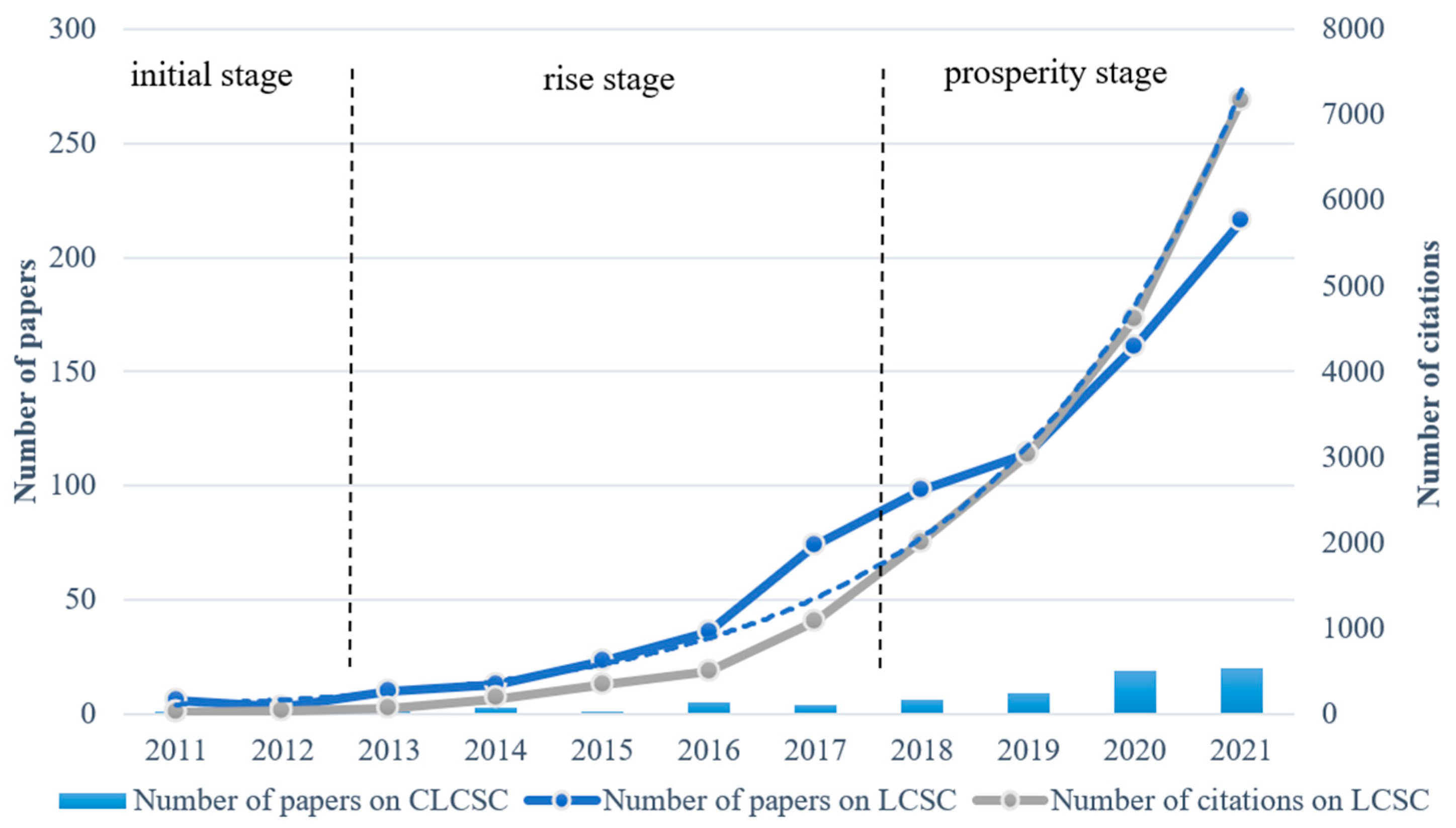

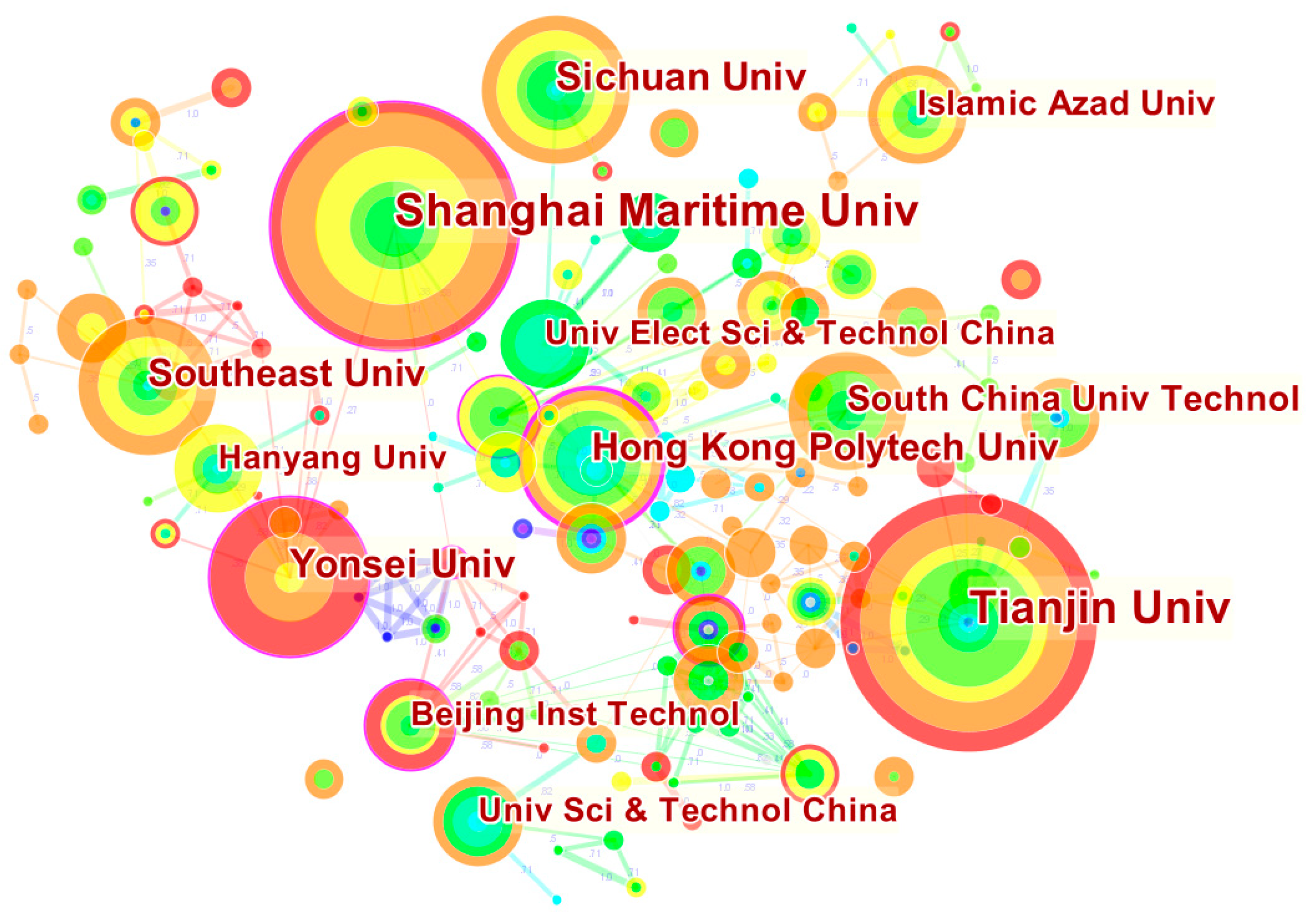
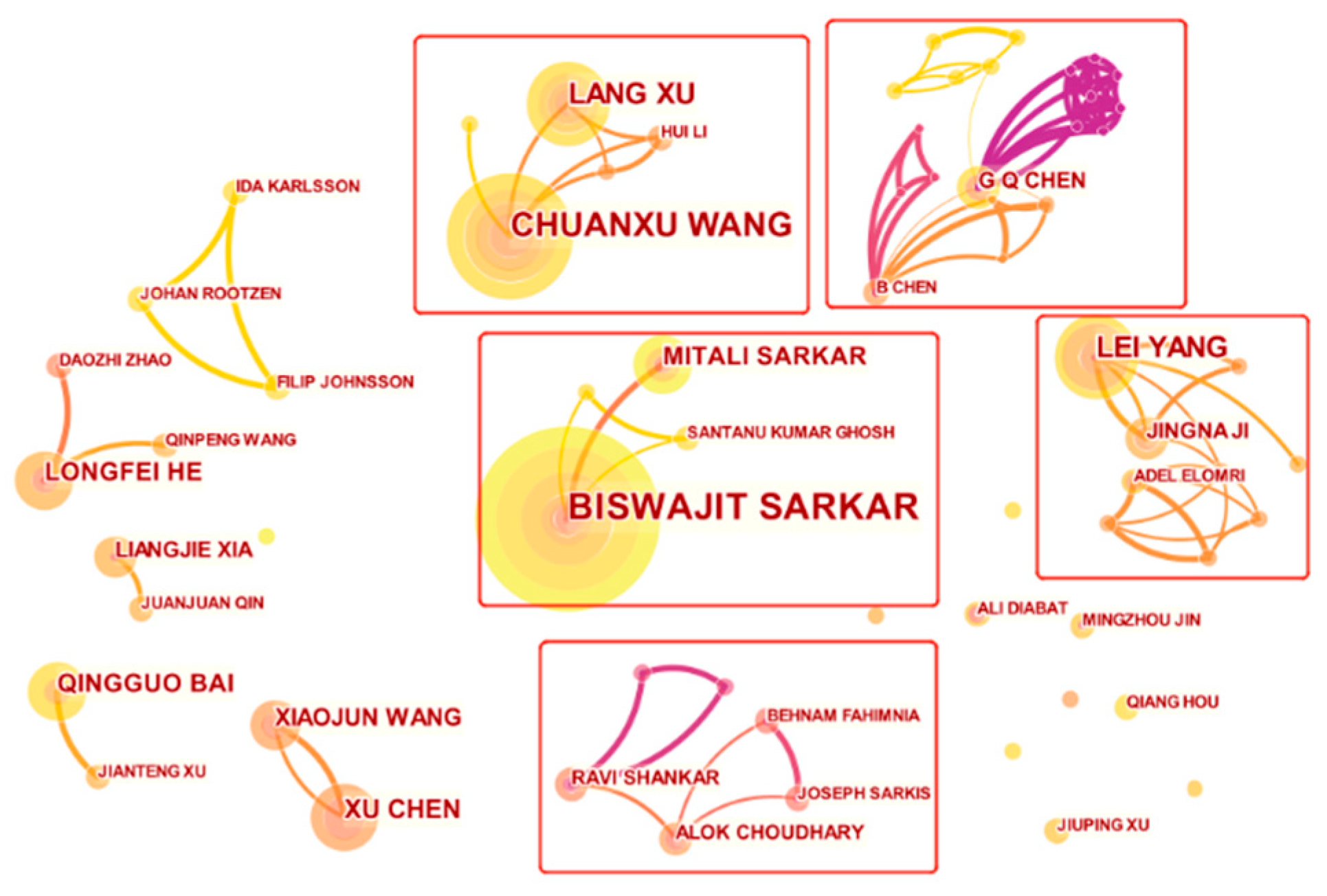

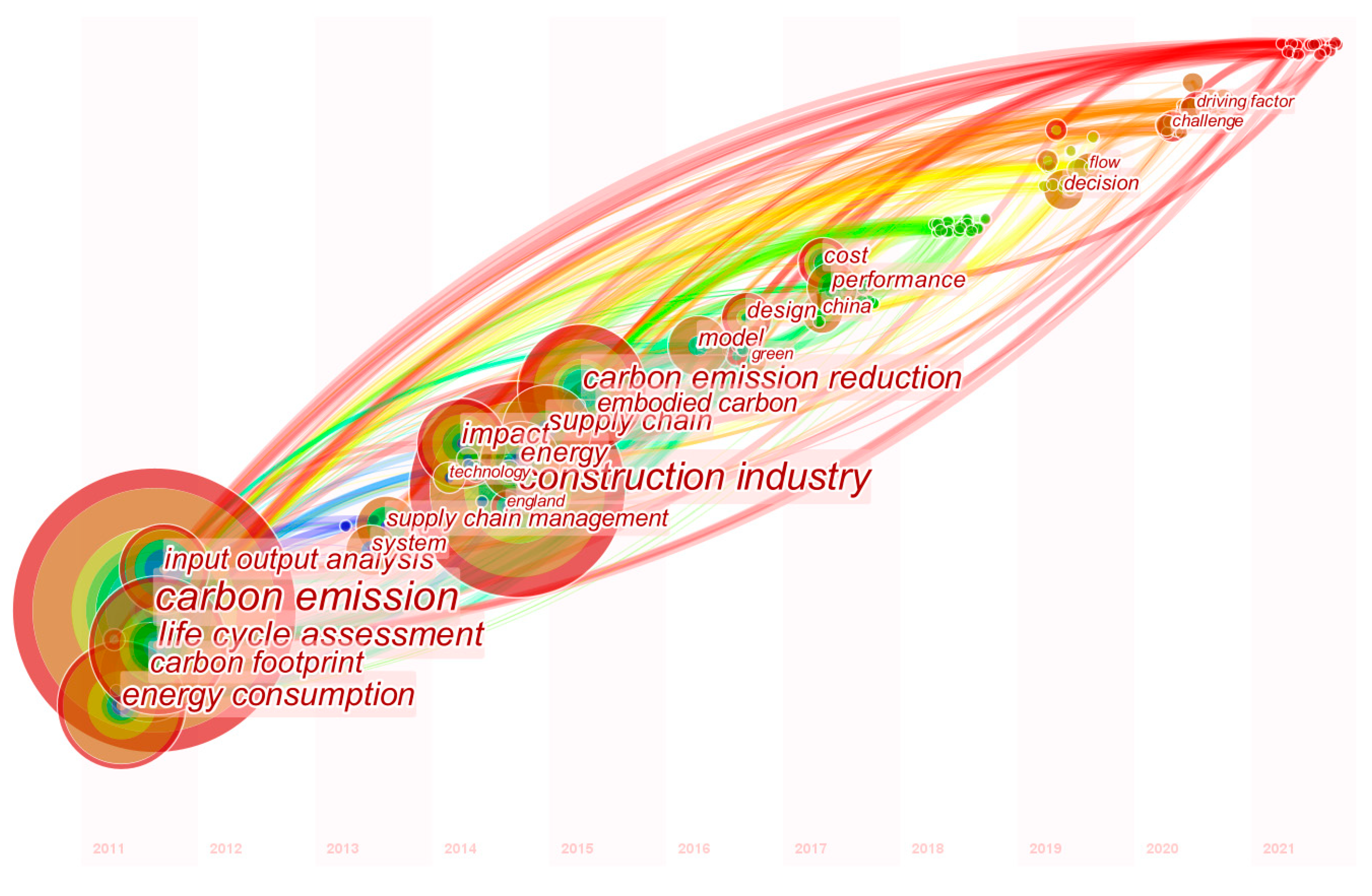
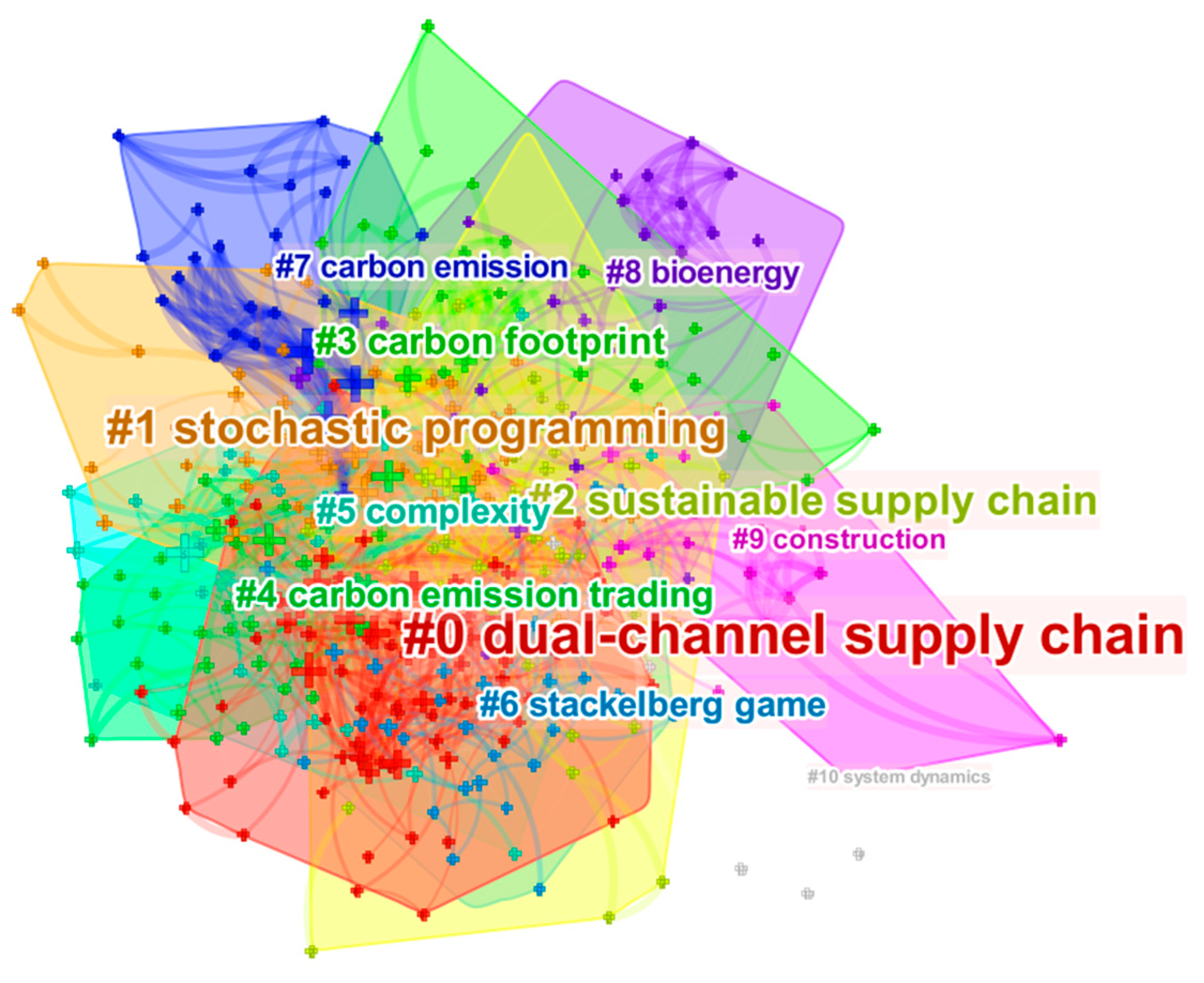
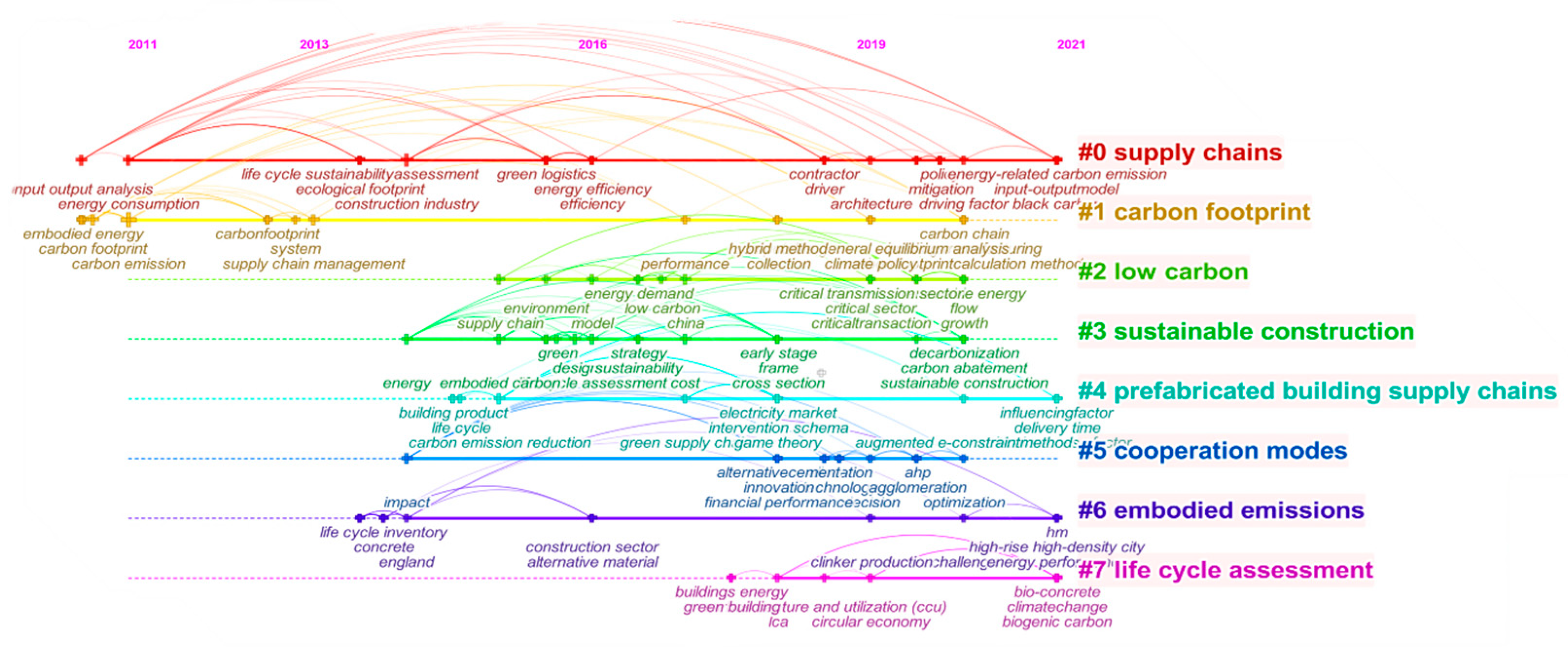
| Institution | Country | Counts | Centrality | Year |
|---|---|---|---|---|
| Tianjin University | China | 26 | 0.08 | 2014 |
| Shanghai Maritime University | China | 25 | 0.13 | 2017 |
| Yonsei University | South Korea | 26 | 0.18 | 2019 |
| Sichuan University | China | 15 | 0.01 | 2015 |
| The Hong Kong Polytechnic University | China | 14 | 0.25 | 2011 |
| No | Count | Year | Authors | Institution |
|---|---|---|---|---|
| 1 | 22 | 2015 | BISWAJIT SARKAR | Yonsei University |
| 2 | 15 | 2017 | CHUANXU WANG | Shanghai Maritime University |
| 3 | 10 | 2014 | LEI YANG | South China University of Technology |
| 4 | 10 | 2017 | LANG XU | Shanghai Maritime University |
| 5 | 8 | 2016 | XU CHEN | University of Electronic Science and Technology of China |
| 6 | 7 | 2014 | LONGFEI HE | Tianjin University |
| 7 | 7 | 2016 | MITALI SARKAR | Department of Industrial Engineering, Seoul National University |
| 8 | 7 | 2018 | QINGGUO BAI | Qufu Normal University |
| Author | Year | Title | Source | Count | Centrality | Citations | |
|---|---|---|---|---|---|---|---|
| 1 | Saif Benjaafar | 2013 | Carbon footprint and the management of supply chains: insights from simple models | IEEE Transactions on Automation Science and Engineering | 90 | 0.05 | 1190 |
| 2 | Jingna Ji | 2017 | Carbon emission reduction decisions in the retail-/dual-channel supply chain with consumers’ preference | Journal of Cleaner Production | 86 | 0.03 | 239 |
| 3 | Qinpeng Wang | 2016 | Contracting emission reduction for supply chains considering market low-carbon preference | Journal of Cleaner Production | 63 | 0.03 | 160 |
| 4 | Shaofu Du | 2015 | Game-theoretic analysis for an emission-dependent supply chain in a ‘cap-and-trade’ system | Annals of Operations Research | 58 | 0.03 | 229 |
| 5 | Xiaoping Xu | 2017 | Supply chain coordination with green technology under cap-and-trade regulation | International Journal of Production Economics | 53 | 0.04 | 261 |
| Keyword | Citation | Centrality | Year |
|---|---|---|---|
| supply chain management | 147 | 0.09 | 2011 |
| model | 136 | 0.03 | 2012 |
| supply chain coordination | 132 | 0.02 | 2015 |
| policy | 103 | 0.03 | 2015 |
| optimization | 102 | 0.04 | 2015 |
| Clustering Characteristics | Value | |
|---|---|---|
| Cluster quality | Modularity | 0.5244 |
| Silhouette | 0.7588 | |
| Cluster quantity | 11 | |
| Cluster Label (LLR) | Main Keywords | Capacity | Silhouette | Year | ||
|---|---|---|---|---|---|---|
| Methods | #1 | stochastic programming | carbon policies; closed-loop supply chain; uncertainty | 57 | 0.677 | 2016 |
| #3 | carbon footprint | international trade; footprint; input-output analysis | 36 | 0.744 | 2015 | |
| #6 | stackelberg game | differential game; games; green products | 31 | 0.795 | 2018 | |
| #10 | system dynamics | theoretical analysis; incentive policy; partnership | 9 | 0.92 | 2015 | |
| Object | #0 | dual-channel supply chain | cap-and-trade; low-carbon preference | 82 | 0.6 | 2017 |
| #2 | sustainable supply chain | supplier evaluation; low carbon; performance evaluation | 47 | 0.788 | 2015 | |
| #8 | bioenergy | technology; renewable energy | 27 | 0.852 | 2015 | |
| #9 | construction | embodied carbon; building materials buildings | 20 | 0.903 | 2016 | |
| Policy | #4 | carbon emission trading | deteriorating items; inventory; imperfect quality | 35 | 0.813 | 2017 |
| No | Capacity | Cluster Label (LLR) | Silhouette | Keywords | Representative Literature | Year |
|---|---|---|---|---|---|---|
| #0 | 33 | supply chains | 0.831 | construction industry; developers; input output analysis | Chen, et al. [56]; Giesekam, Barrett, Taylor and Owen [47] | 2016 |
| #1 | 24 | carbon footprint | 0.928 | national climate policy; building manufacturing | Sun [57]; Hong, et al. [58] | 2014 |
| #2 | 24 | low carbon | 0.849 | simulation; flow; greening global value chains | Papachristos, et al. [59]; Chen, et al. [60] | 2018 |
| #3 | 23 | sustainable construction | 0.842 | carbon abatement; decarbonization | Seo, et al. [61]; He, et al. [62] | 2017 |
| #4 | 20 | prefabricated building supply chains | 0.837 | intervention schemas; delivery time; governmental regulation; structural equation modeling | Waltho, et al. [63], He, et al. [64] | 2017 |
| References | Year | Strength | Begin | End | 2011–2021 |
|---|---|---|---|---|---|
| Benjaafar, Li and Daskin [23] | 2013 | 23.07 | 2014 | 2018 |  |
| Chaabane, et al. [78] | 2012 | 14.52 | 2013 | 2017 |  |
| Hua, et al. [42] | 2011 | 12 | 2014 | 2016 |  |
| Du, et al. [79] | 2013 | 10.08 | 2014 | 2018 |  |
| Liu, et al. [80] | 2012 | 10.03 | 2015 | 2017 |  |
| References | Year | Strength | Begin | End | 2011–2021 |
|---|---|---|---|---|---|
| Azari and Kim [81] | 2016 | 1.04 | 2018 | 2019 |  |
| Bing, et al. [82] | 2015 | 1.02 | 2016 | 2017 |  |
| Chaabane, et al. [78] | 2012 | 1.02 | 2016 | 2017 |  |
| Atmaca and Atmaca [83] | 2015 | 1.02 | 2016 | 2017 |  |
| Chau, et al. [84] | 2012 | 0.91 | 2015 | 2017 |  |
| Field | Keywords | Year | Strength | Begin | End | 2011–2021 |
|---|---|---|---|---|---|---|
| LCSC | carbon footprint | 2011 | 7.55 | 2011 | 2016 |  |
| inventory | 2011 | 3 | 2015 | 2016 |  | |
| game theory | 2011 | 2.69 | 2017 | 2018 |  | |
| green logistics | 2011 | 2.6 | 2016 | 2017 |  | |
| design | 2011 | 2.4 | 2013 | 2016 |  | |
| carbon emission | 2011 | 2.3 | 2013 | 2014 |  | |
| facility location | 2011 | 2.24 | 2017 | 2018 |  | |
| choice | 2011 | 2.2 | 2015 | 2017 |  | |
| distribution system | 2011 | 2.18 | 2015 | 2016 |  | |
| stochastic demand | 2011 | 2.08 | 2016 | 2017 |  | |
| CLCSC | cost | 2011 | 1.19 | 2017 | 2019 |  |
| decision | 2011 | 1.15 | 2019 | 2021 |  | |
| embodied carbon | 2011 | 1.15 | 2015 | 2016 |  | |
| input output analysis | 2011 | 1.11 | 2011 | 2014 |  | |
| carbon emission reduction | 2011 | 1.03 | 2015 | 2016 |  | |
| green supply chain | 2011 | 0.98 | 2017 | 2018 |  | |
| carbon footprint | 2011 | 0.98 | 2011 | 2013 |  | |
| environment | 2011 | 0.95 | 2016 | 2017 |  | |
| life cycle inventory | 2011 | 0.94 | 2014 | 2016 |  | |
| attitude | 2011 | 0.94 | 2014 | 2016 |  |
Publisher’s Note: MDPI stays neutral with regard to jurisdictional claims in published maps and institutional affiliations. |
© 2022 by the authors. Licensee MDPI, Basel, Switzerland. This article is an open access article distributed under the terms and conditions of the Creative Commons Attribution (CC BY) license (https://creativecommons.org/licenses/by/4.0/).
Share and Cite
Du, Q.; Zhou, J. Evolution of Low Carbon Supply Chain Research: A Systematic Bibliometric Analysis. Int. J. Environ. Res. Public Health 2022, 19, 15541. https://doi.org/10.3390/ijerph192315541
Du Q, Zhou J. Evolution of Low Carbon Supply Chain Research: A Systematic Bibliometric Analysis. International Journal of Environmental Research and Public Health. 2022; 19(23):15541. https://doi.org/10.3390/ijerph192315541
Chicago/Turabian StyleDu, Qiang, and Jiajie Zhou. 2022. "Evolution of Low Carbon Supply Chain Research: A Systematic Bibliometric Analysis" International Journal of Environmental Research and Public Health 19, no. 23: 15541. https://doi.org/10.3390/ijerph192315541
APA StyleDu, Q., & Zhou, J. (2022). Evolution of Low Carbon Supply Chain Research: A Systematic Bibliometric Analysis. International Journal of Environmental Research and Public Health, 19(23), 15541. https://doi.org/10.3390/ijerph192315541






